| OCTOBER 2017 |
| Kabukiza (T˘ky˘) |  |
| Dates | 1 ~ 25 October 2017 (Jűgatsu ďkabuki) October Grand Kabuki |
| MatinÚe | |
| Evening |
Kanjin Kanmon Tekuda no Hajimari Aki no Irokusa |
| Casting |
Living National Treasure Onoe Kikugor˘, Living National Treasure Band˘ Tamasabur˘, Nakamura Tokiz˘, Onoe Kikunosuke, Nakamura Shikan, Nakamura Ganjir˘, Nakamura Shichinosuke, Onoe Matsuya, Ichikawa Danz˘, Ichikawa Sadanji, Band˘ Hikosabur˘, Band˘ Rakuzen, Ichimura Manjir˘, ďtani Tomoemon, Kataoka Kamez˘, Kawarasaki Gonjűr˘, Band˘ Shűch˘, Band˘ Kamez˘, Ichikawa Komaz˘, Nakamura Baishi, Nakamura Mantar˘, ďtani Hirotar˘, Nakamura Yonekichi, Nakamura Fukunosuke, Nakamura Kotar˘, Nakamura Tanenosuke, Ichimura Takematsu, Ichimura Kitsutar˘ |
| Comments |
The two highlights are the staging of a newly-created Kabuki drama entitled "(Kiwametsuki Indoden) MahÔbÔrata Senki" and the revival of Namiki Gohei I's drama "Kanjin Kanmon Tekuda no Hajimari". The former drama is based on the famous epic narrative "MahÔbhÔrata". It is staged to celebrate the 60th anniversary in 2017 of the Cultural and Friendship Agreement between Japan and India (signed in 1957). The latter drama was staged for the last time 23 years ago, in October 1994 at the Kabukiza.
|
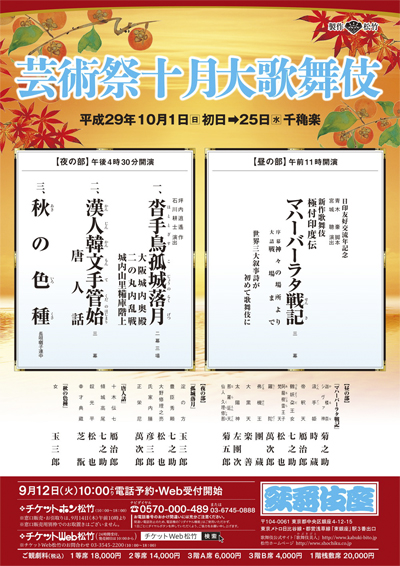 |
| National Theatre (T˘ky˘) |
| Dates | 3 ~ 27 October 2017 |
| Program | |
| Casting |
Living National Treasure Kataoka Nizaemon, Nakamura Jakuemon, Nakamura Kinnosuke, Kataoka Takatar˘, Kataoka Hidetar˘, Band˘ Yajűr˘, Nakamura Karoku, Nakamura Matagor˘, Kamimura Kichiya, Nakamura Hashinosuke, Nakamura Kash˘, Kataoka Matsunosuke, Nakamura Baika |
| Comments |
Tsuruya Nanboku IV's spectacular drama "Reigen Kameyama Hoko" is staged for the 3rd time with Living National Treasure Kataoka Nizaemon in the role of the villain. It was previously staged in October 2002 at the National Theatre and in January 2009 at the Sh˘chikuza.
|
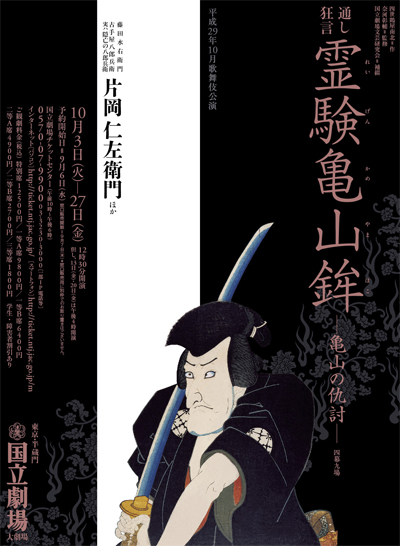 |
| Dates | 21 October 2017 (Dent˘ Kabuki Hozonkai Kenshű Happy˘kai) Training Recital of the Organization for the Preservation of Kabuki |
| Program |
Ichi-no-Tani Futaba Gunki (Kumagai Jin'ya) Otanoshimi Zadankai |
| Casting | |
| Comments |
20th Training Recital at the National Theatre produced by the Organization for the Preservation of Kabuki. "Otanoshimi Zadankai" (literally "Enjoyable Roundtable Discussion") is a stage speech with Living National Treasure Kataoka Nizaemon, Nakamura Jakuemon, Nakamura Kinnosuke, Kataoka Takatar˘, Kataoka Hidetar˘, Band˘ Yajűr˘, Nakamura Karoku and Nakamura Matagor˘.
|
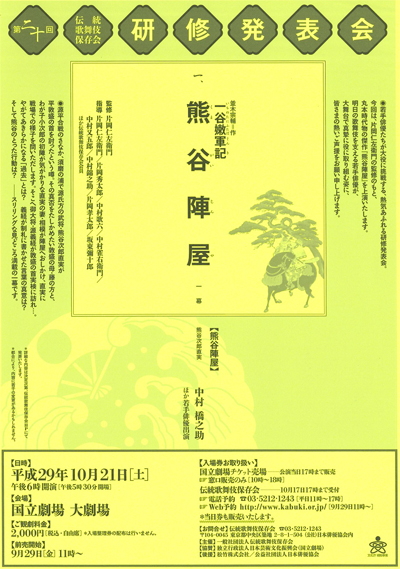 |
| Nagoya (NTK Hall) |
| Dates | 1 ~ 25 October 2017 (Kinshű Nagoya Kaomise) Autumn Brocade Nagoya Face-Showing Program |
| MatinÚe | |
| Evening |
Haru o Kasanete Shikai Nami [ |
| Casting |
Living National Treasure Nakamura T˘z˘, Nakamura Baigyoku, Nakamura Kaishun, Kataoka Ainosuke, Nakamura Kazutar˘, Nakamura Matsue, Nakamura Kikaku, Nakamura Kamenoj˘, Nakamura Kichinoj˘, Nakamura Jűjir˘, Arashi Kitsusabur˘, Nakamura Umemaru |
| Comments |
The October kaomise programs in Nagoya. As the Misonoza closed in Spring 2013 for rebuilding, these programs are staged at the Nihon Tokushu T˘gy˘ Shimin Kaikan for the 5th time, a venue commonly called NTK Hall in Nagoya. This is the last kaomise at the NTK Hall as the Misonoza will reopen in April 2018.
|
 |
| Shinbashi Enbuj˘ (T˘ky˘) |  |
| Dates | 6 October ~ 25 November 2017 (SűpÔ Kabuki Sekando) Super Kabuki II |
| Program |
ONE PIECE |
| Casting |
Ichikawa Ennosuke, Band˘ Takesabur˘, Ichikawa Udanji, Ichikawa Monnosuke, Ichikawa Omez˘, Ichikawa Emisabur˘, Ichikawa Emiya, Ichikawa En'ya, Ichikawa Juen, Ichikawa K˘tar˘, Band˘ Minosuke, Band˘ Shingo, Nakamura Hayato, Onoe Ukon |
| Comments |
The SűpÔ Kabuki Sekando drama "ONE PIECE", based on Oda Eiichir˘'s internationally popular manga "ONE PIECE", which got his first very successful stage adaptation by Ichikawa Ennosuke in October 2015/November 2015 at the Shinbashi Enbuj˘, is staged one more time in T˘ky˘. Most of the actors are Kabuki actors, with 3 non-Kabuki guest actors : Hira Takehiro, Kashima Noritoshi and Asano Kazuyuki. It is almost the same cast as in 2015 (minor differences).
|
| Classics Tour | |
| Dates | 12 October ~ 25 November 2017 (Koten he no Izanai ~ Shűki K˘en) Invitation to the Classics ~ Fall Performances |
| Program |
Otokodate Hana no Yoshiwara |
| Casting |
Ichikawa Ebiz˘, Kataoka Ichiz˘, Ichikawa Kudanji, ďtani Hiromatsu |
| Comments |
The Fall Tour of Ichikawa Ebiz˘ with performances in 17 cities.
|
| NHK Hall (T˘ky˘) | |
| Dates | 28 October 2017 (Koten Gein˘ Kansh˘ Kai) |
| Program | |
| Casting |
Living National Treasure Nakamura T˘z˘, Nakamura Shikan, Band˘ Yajűr˘, Nakamura Kotar˘, Nakamura Hashinosuke, Ichimura Kitsutar˘ |
| Comments |
44th edition of Koten Gein˘ Kansh˘ Kai (literally the "Classics Entertainment Appreciation Association"), a yearly performance produced by the National TV network NHK. The program includes traditional music, one ky˘gen and one Kabuki drama.
|
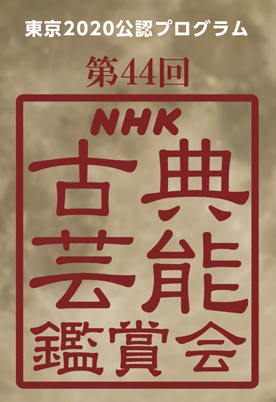 |
|
|||
| Dates | 31 October ~ 5 November 2017 (Band˘ Tamasabur˘ Tokubetsu Buy˘ K˘en) Band˘ Tamasabur˘ Special Dance Performances |
||
| MatinÚe | |||
| Evening |
Inabune |
||
| Casting |
Living National Treasure Band˘ Tamasabur˘ |
||
| Comments |
A special Buy˘ program starring the amazing Living National Treasure onnagata Band˘ Tamasabur˘ in Yamaga at the Yachiyoza, a traditional wooden-built theater. For the first time, with these programs, there will be a mix of video projection (with video sequences coming from the high-quality Shinema Kabuki, "Cinema Kabuki") and real dancing on stage. In "Sagi Musume", only the opening sequence is video-projected. Most of the dance will be performed on staged by Band˘ Tamasabur˘. "Musume D˘j˘ji", the travel scene (michiyuki) is skipped and the kaneiri scene ("entering the bell") is video-projected. Others main scenes, like the koi no tenarai scene ("learning about love"), are staged.
|
||
| ďsaka IMP Hall (ďsaka) |
| Dates | 27 ~ 28 October 2017 (Kabuki Tokubetsu K˘en) Special Kabuki Performances |
| Program | |
| Casting |
Nakamura Ganjir˘, Kataoka Ainosuke, Nakamura Kazutar˘, Nakamura Tanenosuke |
| Comments |
A special Kabuki dance program which is part of the 2017 edition of the ďsaka Culture and Arts Festival (ďsaka Bunka Geijutsu Fesu):
|
| Shibuya-ku Bunka S˘g˘ Center ďwada (T˘ky˘) |  |
| Dates | 4 October 2017 |
| Program |
Shibuya Konn˘maru Densetsu |
| Casting | |
| Comments |
A newly-created Kabuki dance at the Shibuya-ku Bunka S˘g˘ Center ďwada. Ichikawa Somegor˘ shares the stage with the dance masters Onoe Kikunoj˘ III and Onoe Miyako. |
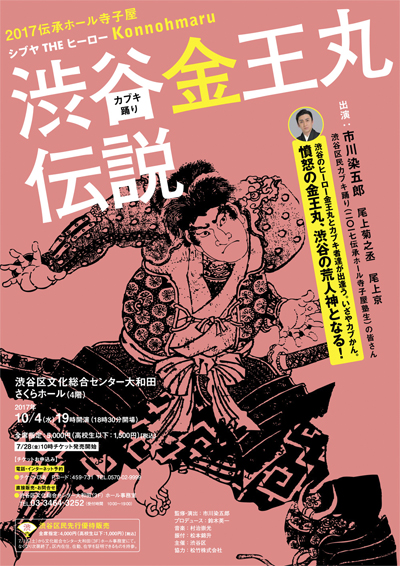 |
|
|
| Contact | Main | Top | Updates | Actors | Plays | Playwrights | Programs | Links | FAQ | Glossary | Chronology | Illustrations | Prints | Characters | Derivatives | Theaters | Coming soon | News |